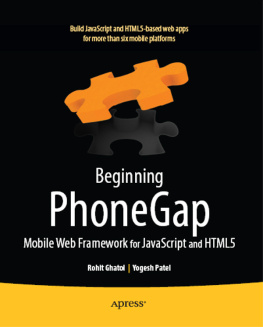
Scott La Counte is a librarian at the Anaheim (CA) Public Library. He is the author of the book Quiet, Please: Dispatches from a Public Librarian (Da Capo Press, 2008), which began as a series for McSweeneys Internet Tendencies. He teaches writing online for the Gotham Writers Workshops. He is also currently in charge of app development at Minute Help Press.
2012 by the American Library Association. Any claim of copyright is subject to applicable limitations and exceptions, such as rights of fair use and library copying pursuant to Sections 107 and 108 of the U.S. Copyright Act. No copyright is claimed for content in the public domain, such as works of the U.S. government.
Extensive effort has gone into ensuring the reliability of the information in this book; however, the publisher makes no warranty, express or implied, with respect to the material contained herein.
ISBNs: 978-1-937589-04-2 (paper); 978-1-937589-14-1 (PDF); 978-1-937589-16-5 (ePub); 978-1-937589-15-8 (Kindle).
Library of Congress Cataloging-in-Publication Data
La Counte, Scott, 1978
Build your own app for fun and profit / Scott La Counte.
p. cm.
Includes index.
Summary: Aimed squarely at the entrepreneur who knows little about mobile applications but is eager to know more, this primer explains in simple language this fast-growing segment of the world economy. The burgeoning smartphone and tablet market presents opportunities and new income streams for enterprising business managers. Avoiding jargon and technical language, the basics of mobile web applications are explained, and practical advice about using open-access development tools such as PhoneGap are discussed. A sample app is developed through the course of the book, providing a handy model for the reader. Even rookie developers with no programming experience will be able to create effective mobile applications using this handy introduction to a thriving billion-dollar industry-- Provided by publisher.
ISBN 978-1-937589-04-2 (pbk.) ISBN 978-1-937589-14-1 (pdf) ISBN 978-1-937589-15-8 (kindle) 1. Smartphones--Programming. 2. Applicaton software. 3. HTML (Document markup language) I. Title.
QA76.76.A65L32 2012
006.76dc23
2012002404
Series book design by Casey Bayer.
Contents
ONE
Mobile App: A Definition
An app, short for application, is a piece of computer software intended to help the user perform specific tasks. A mobile app is a piece of application software created for use in mobile phones and other handheld devices. Its difficult to write about mobile devices because that phrase can mean so many things. When I say mobile app, does that refer to an app that runs on any phone? Or on a specific phone? Just to be clear, there are two types of cell phones:
Feature phone: A feature phone is what the average person carries in his or her pocket. Although many feature phones are becoming more sophisticated, for the most part, feature phones are the more popular basic phones that you can buy. They make calls, they offer texting, and most can take pictures and have very limited web browsing. More than 80 percent of Americans have a feature phone.
Smartphone: Smartphones are best described as computers in the palm of your hand. Several times more powerful than feature phones, smartphones not only can surf the Internet but also can surf at relatively fast, third/fourth-generation (3G or 4G) speeds. The iPhone, Android, BlackBerry, and Windows Mobile are all examples of this kind of phone.
Many of the ideas in this book are universal; they can be tried on pretty much any phone in existence; the majority of ideas, however, are maximized for use with smartphones.
What is the point of developing apps that fewer than 20 percent of the population can access? Smartphones are the future of cellular technology. Smartphone prices have dropped significantly in recent years. When the iPhone was released in 2007, it cost $599; less than five years later, it cost as little as $99. The same is true of BlackBerries and nearly all other smartphones. As costs continue to drop, the smartphone is becoming more and more affordable to the average consumer.
Mobile development has become one of the biggest growth sectors of web development. People still use computers to surf the Internet, but the amount of time they spend on a computer will decrease as other devices become more prevalent.
The advent of XHTML-MP (XHTML for the Mobile Phone) and WCSS (Wireless CSS) converted two of the most powerful tools in web design into forms that are suitable for those who need to build mobile websites, that is, websites that are specifically designed to be viewed only on mobile phones and not computers. At the same time, WYSIWYG (what you see is what you get) editors currently provide templates for mobile websites, which makes it possible for just about anyone to design simple websites.
Perhaps the biggest reason businesses and other organizations need to embrace this growing technology is because the youth of the world use it to speak to one another. The average teen, if given the option, would probably prefer to text a person than to visit them in person or even call them. If your company is going to continue to grow, then now is the time to start considering the trends of our youththe rapid growth of SmartPhones has proven this trend is not turning into a dying fad. When people buy phones, they are starting to expect apps, and when they dont see them, then they might just go to the company that does. Apps dont have to be flashy, at least right now; being able to tell your customer I see you have an iPhonemake sure and download our app. Its free and tells you a little more about our company is enough to give them the impression that your company is one that values technology.
The beauty of apps is that they are always evolvingtheres plenty of time to grow the app into something that is truly eye-catching; if you can at least get something basic on Apples app store (the online marketplace on which iPhone and iPad apps are sold), however, youll have the competitive edge. For many customers, the app store is becoming more and more like the yellow pages. Need to buy a house? Go to the app marketplace to see whats available. More and more people are finding businesses through the app marketplace than the traditional phone directory. For some businesses, a top-rank match on the app marketplace will lead to ten times more customers than being the first name that pops up in a phone directory.
There are hundreds of thousands of apps, which sounds intimidatinguntil you consider the percentage of these apps that are merely games, fart sound effects, or big corporations like Disney, NBC, and CNN. The percentage of smaller businesses that have apps is next to nothingmeaning in almost every sector, you can get there before your competition does. Dont be intimidated by the numbersthere is still plenty of room and plenty of opportunity to get the competitive edge over other businesses.
What Is a Mobile App?
Another question that should be answered before proceeding any further is, What do I mean by mobile app? Mobile apps generally refer to two different things:
Mobile website: A mobile website is mobile phone-friendly and is developed taking into consideration the limitations of cellular devices. If you invested the right amount of time in your businesss website, it probably looks pretty good on a ten- to twenty-inch screen (the size of the average desktop or laptop screen). But if you try to access the website from a mobile phone, it probably will look pretty lousyif it even loads at all. Having a mobile-friendly website would simply mean that the business has a separate web address (e.g., m.business.comthe
Next page

















